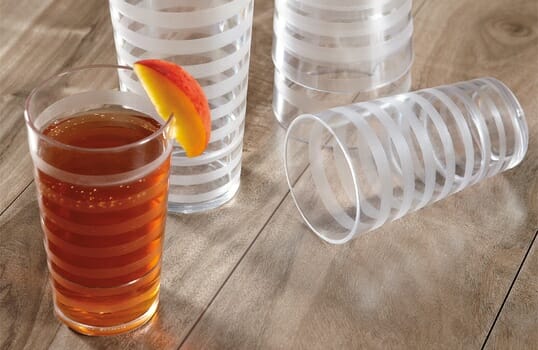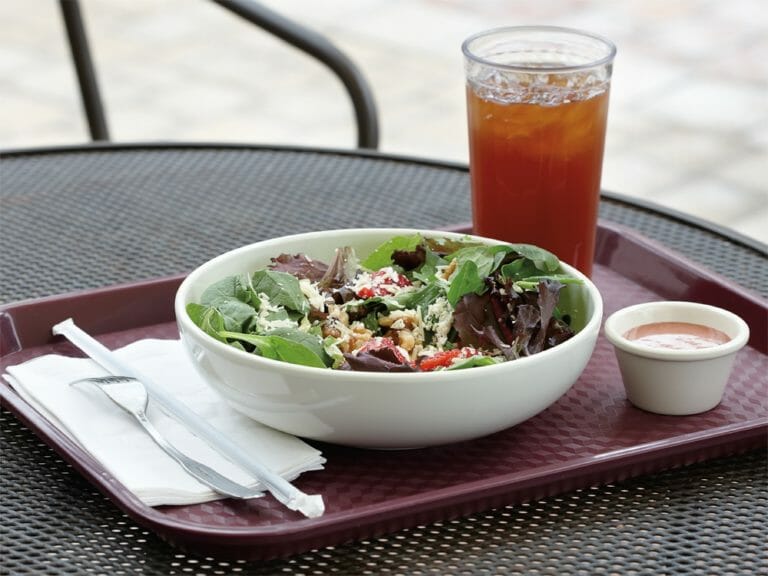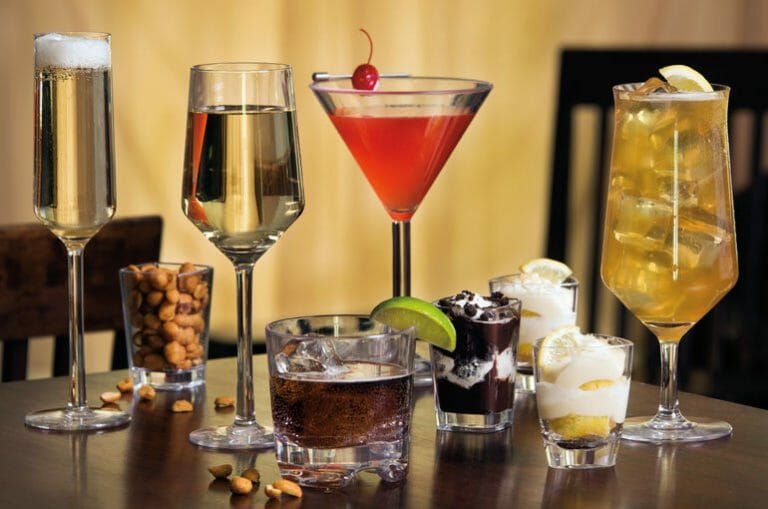How to Choose the Best Plastic Tumblers for High-Volume Foodservice
Plastic tumblers are the go-to drinkware selection for an array of high-volume foodservice providers. But do you know why you order the plastic tumblers you do? Is it because that’s just the way things have always been done? Or is it because you’re well informed about the material they’re made from and you know it’s the best option for your establishment?
If you answered, âBecause that’s the way it’s always been done,â you’re probably in good company. It’s hard to change habits, after all. Here at G.E.T., we believe in arming you, the foodservice operator, with the knowledge to select the best products for your specific needs.
Follow us through this post as we compare the two most popular kinds of drinkware plastics, PC and SAN, foodservice operators use for their tumblers. By the end, you’ll know whether you want to stick with your usual purchase or if it’s time to switch. Better yet, you’ll know why.
What are PC and SAN Plastics?
In short, they’re two plastic polymers commonly used in food-safe plastics. PC stands for polycarbonate, and SAN stands for styrene-acrylonitrile. Their clunky, formal names make it easy to understand why the abbreviated versions are preferred.
They each have pros and cons regarding appearance, durability, and potential replacement rates. Let’s take a look.

Pictured: G.E.T. Orbisª Tumblers, Tahitiª Tumblers, and Textured Bell Soda Tumblers.
What do PC and SAN Plastic Tumblers Have in Common?
They have more similarities than differences, most of which fall under the âproâ category:
- Excellent clarity, often as clear as glass drinkware
- Durable, but to varying degrees
- Dishwasher-safe
- Customizable
- Not microwave-safe, but tumblers almost never need to be microwaved since their primary use is tea, soda, and water service
You may be hard-pressed to tell the difference between some more formal tumbler designs made from plastic vs. glass by simply looking at them. But tried-and-true plastic tumblers designed with a casual look are also widely used. Operators often take advantage of the ability to customize their plastic tumblers, which is possible with both materials. These drinking glasses are in front of guests during the entire dining cycle, so they’re the perfect opportunity to add your brand’s logo, distinctive design, or colors to your plastic tumblers.
KEY TAKEAWAY: Both PC and SAN design capabilities fit a range of styles and levels of formality.
You can see the many positive, shared qualities both materials offer. But the differences are what will help you find the right candidate for your particular establishment, so let’s dive into those.

Pictured: G.E.T. Streamª Tumblers, Bahamaª Tumblers, and Textured Tumblers.
How do PC and SAN Tumblers Perform Differently in High-Volume Foodservice?
Even though PC and SAN share some of the same general qualities, they share them in different ways. Their durability performance is a great example of this.
Commercial Dishwasher Performance of SAN vs. PC
Eastman-Kodak conducted a study of PC and SAN, testing for various qualities like clarity, toughness, chemical resistance, etc. Part of this study includes washing both materials in a commercial dishwasher 1,000 times. Inspection of pieces occurred every 100, 250, 500, and 750 wash cycles leading up to the 1,000th wash.
In a high-volume kitchen environment, your plastic tumblers may be washed several times a day. Let’s say your plastic tumblers average 3 wash cycles daily, once per meal segment. Within just less than a year, you’ll have reached 1,000 wash cycles.
Tumblers made with PC will show visible signs of wear after only 100 washes. In our scenario of washing 3 times daily, you may have cracked or hazy tumblers in about a month. But tumblers made with SAN passed every wash cycle up to 1,000. It likely performs well after 1,000 washes, but that’s as far as the test went.
KEY TAKEAWAY: To maintain decent clarity and structural integrity of your tumblers, you may need to replace PC tumblers 10x more often than SAN.
![]()
Like this topic? Tell us why in the comments!

Drop Test Performance of PC vs. SAN
If you work in foodservice, you understand that despite our best efforts, commercial kitchens are rowdy, bustling environments and dishes sometimes get dropped. It’s the nature of the business, which is why Eastman-Kodak also included drop testing in their study.
PC performed better than SAN in this case, with SAN failing on the initial drop. SAN can crack or chip if it’s dropped on a hard surface just once. However, that doesn’t mean that it’s guaranteed to do so, only that the possibility exists.
On the positive side, neither material will shatter like glass, making both of them a safer option. However, if your plastic tumbler is cracked or chipped it should be retired from service because guests may still cut themselves on a chipped rim, or the tumbler may leak.
Design can also play a role in plastic tumblers’ tendency to chip or crack. For example, a well-designed tumbler base may be able to take more of an impact than one that’s poorly attached. That’s why you should try to seek out reputable companies with qualified design engineers when making a purchase decision.
KEY TAKEAWAY: Durability-wise, we have a bit of a role reversal. SAN does better in a commercial dishwasher than PC, but PC does better than SAN in drop tests.

Pictured: G.E.T. Loftª, Revoª, and Spektrumª Tumblers.
Differences in Clarity Between PC and SAN
Overall, both materials have decent clarity, but PC tends to be just a bit better. Some SAN â but not all â can have a faint yellow or blue tint. Tinting comes from the raw materials used to make SAN and is part of the manufacturing process.
Whether SAN tumblers have a tint to them can depend on the raw materials used, the manufacturing process, the tier level you’re considering, and sometimes the thickness of the material. But if you want tumblers in colors other than clear, like red or blue, then it doesn’t matter much which material you use because dyed plastic is enough to cover any tinting.
One difference that may be a deal-breaker is that PC plastic contains BPA and SAN does not. You may have heard concerns over BPA in foodservice materials, but the FDA closely monitors and assesses the levels allowable in food contact surfaces: âBased on FDA’s ongoing safety review of scientific evidence, the available information continues to support the safety of BPA for the currently approved uses in food containers and packaging.â
BPA is an inherent part of PC plastic and can’t be removed from the material. It’s understandable if you prefer to avoid it altogether, in which case SAN would be your only choice between these two plastics. Assuming BPA is not a deal-breaker, let’s take a look at why you may want to use one plastic over the other.
KEY TAKEAWAY: Both PC and SAN have decent clarity, but SAN can sometimes have a slight tint to it, which custom colors can cover. PC contains BPA, but SAN does not, which may be a deal-breaker for some operators.

Take control of your reading experience. Leave a comment below telling us what interests you and we’ll write about it!

Why Choose One Material Over the Other for Your Plastic Tumblers?
Overall, plastic tumblers are great drinkware options for high-volume foodservice because they don’t shatter like glass, making them safer for guests and staff. Their durability advantages over glass also keep their replacements rates lower, saving you money in the long term.
If you’re deciding between PC and SAN, you may want to go with SAN if you know your tumblers are going to be put through the dishwasher several times a day. If your environment is such that plastic tumblers are going to be dropped a lot, perhaps in a bar, then PC may be the better choice.
On the other hand, PC can be a bit clearer than SAN, so if clarity is high on your priority list, PC is an excellent choice, but SAN isn’t far behind.
These materials both work well in high-volume foodservice. Whether you use one over the other for your plastic tumblers is completely up to what’s important to you and your operation. If you want to change the materials you’re currently using for your plastic tumblers, now you can tell your boss why one may work better than the other. Remember the key takeaways:
- Both PC and SAN design capabilities fit a range of styles and levels of formality.
- To maintain decent clarity and structural integrity of your tumblers, you may need to replace PC tumblers 10x more often than SAN.
- Durability-wise, SAN does better in a commercial dishwasher than PC, but PC does better than SAN in drop tests.
- Both PC and SAN have decent clarity, but SAN can sometimes have a slight tint to it, which custom colors can cover. PC contains BPA, but SAN does not, which may be a deal-breaker for some operators.
We will add, however, that regardless of the material you choose, following proper care and maintenance will help you to get the best service life out of your tumblers. We recommend reading â4 Easy Steps to Extend Plastic Drinkware’s Service Lifeâ to benchmark your current care and maintenance system or to develop your own.
Give us a shout out in the comments and let us know what other questions we can answer for you about all the great things plastic drinkware can do for your foodservice establishment. We’d love to hear from you!
{{cta(‘8d97949d-5da3-4d20-be7d-c81134328a61’)}}








